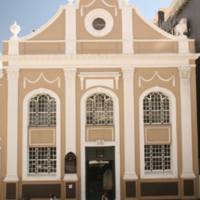
Sendinggestig
The Sendinggestig opened in 1977, situated in an old mission church which still functions for ceremonial purposes though lost its congregation – which mainly comprised poorer black and coloured people – when the terms of the Group Areas Act were applied to inner city spaces. The museum is colloquially referred to as the ‘Slave Church’, reflecting the presence of enslaved people in its original congregation founded in 1804. It is one of 28 museums affiliated with the Western Cape Provincial Government’s Museum Service. As well as providing funding, the Museum Service offers technical support in developing exhibitions. The Sendinggestig was originally conceived as a mission museum, and updated displays installed by the Museum Service in 2011 reflect this focus.
The displays installed in 2011 move beyond Eurocentric interpretations of history to offer a more inclusive history of mission activity and religious freedoms in the Cape Town area. Reference, for example, is made to the connections between slavery and the development of Islam in South Africa. In offering the building space to outside groups and performers, the museum also works to provide opportunities for alternative interpretation. This includes groups who identify with enslaved and Khoisan people as ancestors, and seek to reimagine their lives through song, poetry, and dance. A regular series of public events are held and attract sizeable audiences, whilst 1 December Emancipation Day is marked annually.
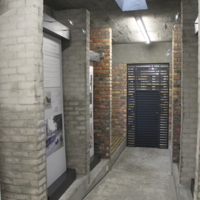
Prestwich Memorial
The Prestwich Memorial opened in 2008 as an attempt at resolving a protracted and sometimes unsavoury dispute sparked in 2003 when a property developer discovered human remains in central Cape Town whilst digging the foundations for an apartment complex. These remains were likely those of the colonial working classes, buried in the many unmarked eighteenth and nineteenth century graves. For certain activists, the remains were identified as those of their enslaved ancestors. A dispute began between people opposing exhumation on the grounds of respect for ancestors, versus those who advocated exhumation owing to the unprecedented opportunities offered to furthering historical and scientific knowledge. Following a public consultation process, the bones were exhumed, but were not subjected to analysis.
The memorial was constructed on behalf of the City of Cape Town municipality to house the remains, and provide an exhibition space to explain the affair. The opening of an artisan coffee shop named Truth in the memorial building in 2010 however created further contestations on the grounds of taste and respect for the dead.
The memorial features a number of fixed interpretation boards which explain the colonial burial system, the unmarked cemeteries beneath the modern city, and the type of people likely to have been buried in them. Enslaved people, of course, feature in this number. The bones themselves are situated in an ossuary area, accessible by a low entrance. They are separated from the public by a wooden gate. Whilst research applications to study the bones are invited, no applications have been accepted at the time of writing by a panel including stakeholders from various sides of the exhumation debate.
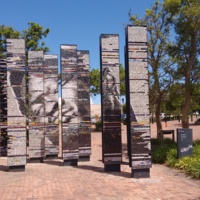
Spier
Spier is a wine estate, situated east of Cape Town close to Stellenbosch. It was founded in 1692 and, as with the majority of South African wine farms of a similar age, its early labour force rested on enslavement. Spier was one of the first wine farms to develop itself as a tourist attraction during the 1960s and 1970s, reflecting a shift in the Winelands economy from just the production of wine. Presently, Spier offers visitors a number of restaurants, wine tasting, conferencing facilities, accommodation, a market, and a variety of estate tours including by Segway. Historical features have been preserved and form part of these tours.
Spier is quite open about its past involvement in slavery. The 1825 slave bell has been restored and is highlighted on the audio tour of the estate. In 2012, an art piece named ‘The Dying Slave’ was designed by the South African artist Marco Cianfanelli and installed at the base of the hotel car park at Spier. This large and imposing structure consists of nine columns which, when the viewer stands at a distance, combine to produce an image which was inspired by Michelangelo’s image of a ‘Dying Slave’.
More obvious local connections with slavery are evident in the ‘Gables' audio tour launched in 2012. This is narrated by a fictional enslaved woman named Sannie de Goede and set in 1836 on the eve of the ending of the apprenticeship period. Using the smartphone app VoiceMap, the narrator guides the visitor around the estate, drawing attention to historical features from the perspective of someone who was forced to work on the estate. Written by playwright Brett Bailey, it should be viewed as part of a genre of historical fiction including works such as Yvette Christianse’s Unconfessed which seek to fill gaps in the colonial archive by reimaging the voices of enslaved women.
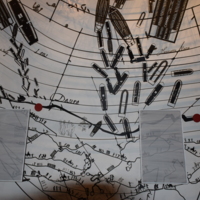
Freedom Park
Freedom Park opened in 2006 having been established as a Legacy Project of South Africa’s second democratically-elected president, Thabo Mbeki. Nine sites were established as Legacy Projects, receiving ample state funding as spaces considered priority sites in preserving national history. Freedom Park was conceived as a national memorial, with a central feature being the 'Wall of Names'; a memorial wall displaying the names of people associated with eight ‘struggle’ epochs which the site considers to define South African history. Elsewhere, evidence of the influence of Mbeki’s ‘African renaissance’ philosophy is prominent. Memorial features in the ‘Isivivane’ area include a symbolic burial ground titled ‘Lesaka’, and ‘Lekgotla’, an African meeting place surrounding the trunk of a uMlahlankosi tree.
A museum, named //hapo (‘dream’ in Khoi) opened in 2013, introducing explicitly didactic content to Freedom Park for the first time. Much like the ‘Wall of Names’, this is grouped into eight ‘struggle’ epochs. It weaves an Africanist narrative beginning by positing the continent as the cradle of mankind, and ending by suggesting that Africans can look to the past to solve the problems of the present, many of which it links with European colonisation. Freedom Park operates a substantial educational and visitor tour programme.
Freedom Park is the only museum in South Africa outside the former slave trading epicentre which is now the Western Cape to cover slavery in any detail. Slavery features as an epoch on both the ‘Wall of Names’ and in //hapo. With the former, it is not clear whether the names displayed are actually those of people enslaved in South Africa, as some of the names are more indicative of transatlantic slave naming patterns. In //hapo, the epoch titled ‘Peopling’ details how Europeans viewed Africa as a market for human beings. A number of artefacts – some of which were created for the museum – depict African life prior to the arrival of Europeans, whilst an installation by the Johannesburg-based artist Clive van den Berg portrays departure. Slavery depicted in //hapo therefore is transatlantic slavery, rather than the very different system of slavery evident in South Africa.
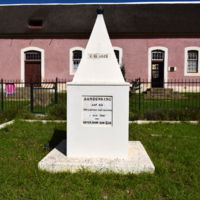
Elim Heritage Centre
Elim Heritage Centre was opened in 2009 in the Moravian mission village of Elim. Situated in the former mission store, it relies on funding from a grant by SAN Parks which permits a modest salary for its sole member of staff. Elim was established in 1824 and, in common with other mission stations in the area, saw an influx of newly freed people following the end of the post-abolition apprenticeship period in 1838. The centenary of the ending of the apprenticeship period in 1938 was marked in Elim by a monument situated across the road from the Moravian Mission Church. A feasibility study for an Elim offshoot of UNESCO’s Cape leg of its Slave Route project in the late 1990s revealed that many Elim residents were unaware about their slave heritage. Although the feasibility study did not amount to a longer-term UNESCO project, the undertaking did encourage interest in slave history in Elim. The 1938 monument was rededicated in 2004, and the Heritage Centre’s foundation can be traced to the feasibility study. As well as featuring as a community repository including donated trade and home objects, photographs, and clothing, its collections include a series of display panels created by the Slave Route feasibility study.
The Heritage Centre’s displays are modest and consist mainly of photographs pinned to display boards. There is little on slavery itself, although one primarily photographic panel shows a clear pride in the 1938 memorial and the way in which it has functioned as a form of remembering slavery over time in Elim. Reference is made to 1 December Emancipation Day as a way of reconnecting with ancestors. Another display details the genealogical origins of Elim, giving the names of early settlers among whom formerly enslaved people are clearly evident. The Slave Route display panels are not on open display. Indeed, it is the behind the scenes work of the curator where the Heritage Centre’s connections with slavery become more apparent. It holds substantial church records, and the curator assists with genealogical enquiries from around the world, including from people researching their slave ancestry.

Swellendam Drostdy Museum
Swellendam Drostdy Museum is one of 28 museums affiliated with the Western Cape Provincial Government's Museum Service. The museum is located in the former court complex in Swellendam, built in 1747 when Swellendam was situated on the frontier of the Dutch Cape of Good Hope. It was founded in 1939 and its displays are somewhat dated and offer a Eurocentric interpretation of the past. The collective heritage of Swellendam is represented through a magistrate's chamber, court room, and a number of domestic settings where the landdrost and his family would have relaxed between the important duties of enforcing European jurisdiction. A safe, the only original item from the building not destroyed in an 1865 fire, occupies a prominent place as a tangible link to this past.
A display opened in one of the barn outbuildings in 2006 seeking to imagine what this outbuilding may have been like two hundred years previously when it may have functioned as slave quarters. The Drostdy Museum's display illuminates a possible surviving link, doing this through a number of straw sleeping mats, food props, and carts. A series of interpretation panels explain slavery at the Cape and give the names and roles of several people enslaved/indentured at Swellendam Drostdy. In light of this, it is somewhat problematic that the museum created controversy in 2015 when it leased one of its buildings to an upmarket eatery. This was given the name 'The Whipping Post' by its owner in reference to the whipping post which formerly stood adjacent to the jail. Activists and local politicians highlighted the links between slavery and the original whipping post, and the outlet was ultimately renamed 'The Trading Post'.
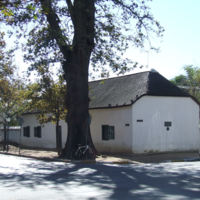
Stellenbosch Village Museum
Stellenbosch Village Museum is one of 28 museums affiliated with the Western Cape Provincial Government’s Museum Service. The Village Museum consists of four period houses dating from the early eighteenth century to the Victorian era. It opened during the 1970s as part of what was then a larger complex of museums in Stellenbosch. The museum was partially redeveloped by Museum Service staff in 2015, with new exhibition panels and an interactive historical timeline installed in the foyer area. Focus is given to the historical origins of Stellenbosch with attention given to a diverse range of historical actors, from the enslaved to Khoi people. This is an important part of moving historical interpretation at the Village Museum away from the whites-only affair established in the apartheid years. Artefacts uncovered during excavations of the period houses and their outbuildings are displayed, though these lack contextual information in places.
Slavery is not referred to in great detail in the exhibition panels, however it does feature on the interactive timeline. Both the abolition of the slave trade in 1807 and abolition of slavery in 1834 are referenced. Efforts are made to posit the Bletterman family – original owners of the Village Museum’s late eighteenth century property - as slave owners. Particular attention is given to the case study of the enslaved woman Manisa who was owned by Stellenbosch resident Johanna Barbara van Biljon. This focus comes from the unusual level of surviving material which enabled a reconstruction of Manisa’s life, including separation from her family through public auction. There is even a full body portrait of Manisa, taken from a Cape Argus article published upon emancipation. Problematically, one of the outbuildings of Bletterman House which potentially functioned as slave quarters has been rented out by the museum and presently houses a number of eateries. No connection is made between references to the outbuildings as slave quarters in the historical timeline and their present use.
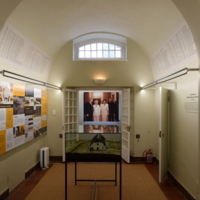
Vergelegen
Vergelegen is a wine estate, founded in 1700 and presently owned by Anglo-American subsidy AmFarms. As with the majority of South African wine farms of such a vintage, its early labour force rested on enslavement. Historical interpretation on the estate can be traced to an archaeological dig conducted by a team of academics from the University of Cape Town between 1990 and 1992. At a time of burgeoning scholarly enquiry into Cape slavery, this work excavated the former slave lodge on Vergelgen with the explicit intention of unearthing items which might hint towards the existence of slave culture. A number of personal items including coins and buttons were discovered, whilst the most significant find was of the skeletal remains of an enslaved woman who was affectionately named ‘Flora’ by estate staff.
The results of the archaeological work were displayed in the estate’s foyer together with contextual information. This made Vergelegen probably the first location in South Africa to mount a detailed exhibition relating to Cape slavery. The existence of the archaeological objects can be considered particularly significant, given that few tangible links with Cape slavery exist in museum collections. A second exhibition focussing on Vergelegen’s historical owners was developed several years later in the former manor house, and both exhibitions were subsequently amalgamated prior to being refreshed in 2016.
Presently, the names of people known to have been enslaved on Vergelegen are listed on the wall/ceiling of the first gallery, whilst the origins of enslaved people and their role on the estate are made clear. The objects unearthed during the early 1990s are displayed as tangible links with a past described by text. Additional historical context focuses on wine farming and the early Cape economy, historical estate owners, and notable visitors to Vergelegen.
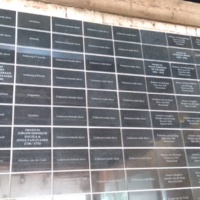
Solms Delta
Solms Delta is a wine estate, situated east of Cape Town in the heart of the Cape Winelands. It was founded as Zandvleit in 1690, with the name change coming in 2002 after purchase by University of Cape Town-based neurosurgeon Mark Solms who wished to distinguish it from other farms with the same name. As with the majority of South African wine farms of a similar age, its early labour force rested on enslavement. Solms approach to farm ownership has seen him attempt to eschew the well-worn white owner/black worker relationship by launching a socio-economic reform project. Money has been invested in new housing featuring satellite television, whilst an education project both for workers and their children has been established. Social enrichment activities based around music, sports, and performance have been encouraged in an attempt to improve the traditionally poor socio-economic circumstances of the workers, many of whom live on the estate just as their ancestors did. Solms has explained in interviews that this refreshed approach to wine farming arises from a perceived responsibility to acknowledge his own life privileges as a white South African. Crucially, workers have been given shares in a land equity scheme.
Solms Delta hosts two museums. One of these, named Museum van de Caab with deference to Cape slave naming patterns, opened at the same time as the estate opened to the public in 2005, with a music museum opening in 2014. Acknowledgement of the past as a means of understanding how workers have been exploited over time is a crucial part of Solms’ project. Slavery is referenced in both museums, with songs as evidence of slave culture appearing in the music museum. In Museum van de Caab it forms a fundamental part of a general farm history which traces the story of the land to the origins of humankind. A memorial feature occupies a prominent position in one of two galleries, detailing the names of every person revealed by archival research to have been enslaved on the estate. Guided museum and estate tours are available, conducted by estate workers.
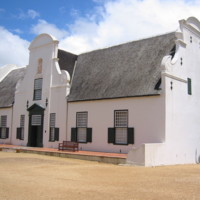
Groot Constantia
Founded in 1685, Groot Constantia is South Africa’s oldest wine estate. Like the majority of wine estates of a similar vintage in the Cape Town area, its labour force prior to emancipation in 1834 rested on enslavement. Following a vine disease outbreak in the late nineteenth century, the estate passed into government ownership. It is currently operated by the arms-length Groot Constantia Trust. The manor house was rebuilt in Cape Dutch style following a fire in 1925, and has operated as a preserved site since that time. The manor house passed into the control of the South African Cultural History Museum in 1969 and, as with other sites managed by the same entity, became part of southern state-funded umbrella Iziko Museums in 1998.
Iziko’s inauguration signalled a shift towards previously marginalised histories at all its sites, with Groot Constantia no different. A revised history of Groot Constantia paying greater attention to enslaved people was written by curator Thijs van der Merwe and published in 1997. Buildings which had potentially served either as stables and/or as slave quarters were repurposed as an Orientation Centre in October 2004. As the first heritage space which the visitor reaches upon arrival, displays in this building foreground the Cloete family – owners from 1779 to 1885 – as ‘farm owners and slave owners’. Drawn from archival research, their human transactions are listed, whilst the origins, names, and worked carried out by people enslaved at Groot Constantia are also listed. A panel is devoted to the ‘young servant boy’ Friday, whose ancestral origins are linked to the suppression of the slave trade by the British Royal Navy. The selection of this story can partially be attributed to the availability of suitable museological material, given that a photograph of Friday carrying Bonnie Cloete’s archery set is included.
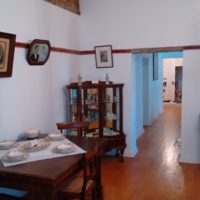
Pniel Museum
Pniel Museum is a small community-run museum which opened in 2013 in the village of Pniel, close to Stellenbosch. It has its roots in a long-running project, dating back to the unveiling of the Freedom Monument on the werf area of the former Papier Moelen manor house (which now houses the museum) in 1993. Pniel itself is a former Apostilic Union mission station which was established in 1843. Many of its early inhabitants were purportedly enslaved people looking for somewhere to settle following the ending of the five year apprenticeship period in 1839. It was designated a rural coloured group area under apartheid. A small group of locals have a clear sense of pride in their history, and embrace their connections with slavery which is taken as Pniel’s formative experience. The Freedom Monument – which celebrates emancipation – was reflective of this, and subsequent developments including two further monuments and the museum have advanced this engagement with the past. The museum itself offers a thorough overview of local history, partially laid out in the form of a historical farmhouse, and partially based on interpretive content. There is no exhibition dedicated to slavery at Pniel Museum, however the links between Pniel and slavery are evident at various points. Additionally, staff (local volunteers) are happy to talk about the links both they and Pniel hold with slavery. Perhaps the most important display in terms of slavery is a family tree of the Willemse family. At the top sits a photograph of Adriaan Willemse who is described as ‘a freed slave who settled on the Pniel mission station and became the father of almost 70% of Pniel inhabitants’. The museum functions as something of a community archive featuring donated objects ranging from cutlery to trade implements. There are, however, no objects which belonged to the village’s early and formerly enslaved inhabitants.
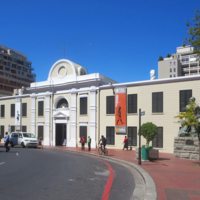
Slave Lodge
The Slave Lodge building was first constructed in 1679 by the VOC as housing for the people they enslaved. It was modified over time, and post-British settlement of the Cape was transformed into government offices. After passing through various stages of administrative use – most notably as the Supreme Court – it opened as the South African Cultural History Museum in 1967.
Typical of apartheid-era museology, its displays made no reference to the building’s connections with slavery. Post-apartheid, the museum was brought under the management of southern state umbrella Iziko Museums, and was renamed Slave Lodge in 1998. Although a number of its displays still date from the Cultural History Museum period, new exhibitions have been installed, and the museum now purports to serve as a centre where human rights abuses are discussed and exposed. There is a particular focus on slavery, and racial segregation under apartheid, both through permanent and temporary displays.
The main slavery exhibition is titled ‘Remembering Slavery’ and opened in 2006. This occupies the western wing of the ground floor of the museum. The exhibition offers a comprehensive overview of Cape slavery, with galleries focussing on contextual history, the Slave Lodge building, the middle passage, slave trading routes in the Indian and Atlantic Oceans, and a recreation of life in the eighteenth century Slave Lodge. Owing to the paucity of material remnants of slavery at the Cape, the exhibition relies on text to a large extent. Tapping in to the ‘reconciliation’ narrative of the early Mandela years, its overall effect is to portray slavery as a South African history which the country has learned from.
The opposite wing of the building hosts a changing selection of temporary exhibitions which have focussed on human rights abuses including the anti-apartheid struggle and women’s rights. The museum offers a comprehensive education programme with a particular focus on slavery.
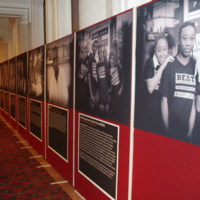
Freedom Roads
The Freedom Roads exhibition at Guildhall Art Gallery was one of several initiatives led by London Metropolitan Archives to mark the bicentenary. The exhibition featured contemporary photographic portraits of people of African origin whose work has contributed to the continuing struggle for human rights in different fields. Colin Prescod, Shirley Thompson, Eric and Jessica Huntley and Rudolph Walker were amongst the individuals featured. Others like the young people from BEAT (Black Experience Archive Trust) were engaged in a project to find out about significant people in their local community. Each person was photographed with an image of an object or place which has a special significance to them. The other part of the exhibition focused on relevant archival materials held by London Metropolitan Archives, including the South African Bill of Rights and a copy of the Constitution signed by Nelson Mandela, Cyril Ramaphosa, F. W. De Klerk and Roelf Meyer. Other material relating to slavery and abolition included a letter from John Julius, a plantation owner on the island of St. Kitts.
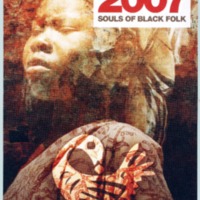
Black History Season Leicester 2007: Souls of Black Folk
Leicester's Black History Season in October-November 2007 marked the bicentenary of the abolition of the slave trade. Its aim was to redress the balance from a 'Eurocentric point of view' of abolition, and focus on the Afrikan perspective with the theme of 'Souls of Black Folk'. Musical performances included gospel, Motown, reggae and jazz. Other events in venues across Leicester and Loughborough included traditional South African dance, contemporary dance, performance poetry, comedy, multimedia performances, storytelling, theatre and an exhibition, 'Africa's Gift', focusing on the economic and cultural contributions of the slaves and their descendants.
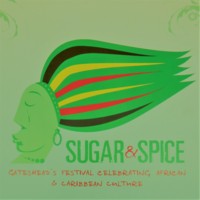
Sugar & Spice
Sugar & Spice was Gateshead's festival celebrating African and Caribbean culture. Held in October 2007, highlights of the programme included 'Mama Africa', South African singer Miriam Makeba; the opera 'Mary Seacole'; a massed performance of 'On Liberation Street' featuring local performers and singers alongside the Grand Union Orchestra; and 'Roll Jordan Roll' featuring jazz trumpeter Abram Wilson performing with the London Community Gospel Choir. The festival weekend also featured street theatre; jazz,blues and gospel music; a light show; and children's arts activities.
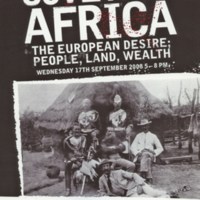
Coveting Africa. The European Desire: People, Land, Wealth
Bishop’s Stortford was the birthplace of the Victorian financier and imperialist Cecil Rhodes. To commemorate the bicentenary of the Abolition Act, Bishop's Stortford Museum and Rhodes Art Complex explored Britain’s imperial ambitions in the ‘Coveting Africa’ exhibition. The museum holds much material from Southern Africa, Zimbabwe, Zambia and Botswana: areas where British colonialism and imperialism in Africa was focused in the nineteenth century. Through a year-long programme of arts events, this project discussed the relationship between Britain and Africa, and explored British attitudes to African peoples. Events included workshops by the London School of Capoeira.